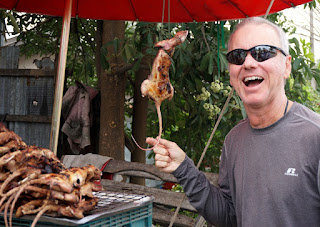January 20, 2018
After rising late, we check out and catch a 10am limo to the Bangkok airport to begin our long 3-flight journey home. It was uneventful. We had clear skies as we approached LAX and the iconic Hollywood sign.
We enjoyed our time in Thailand. Aimee especially loved that Thailand was more civilized and upscale than our last trips to India and Vietnam. It made for safer transportation. We didn’t fear getting run over by motorcycles crossing the street. The people were all very friendly and respectful. Thailand is known as the “Land of Smiles” for good reason.
Aimee loved the shopping. Clothing was surprisingly inexpensive. The Asian art of haggling is a lot less burdensome when the price difference is merely a few pennies.
My desire for the exotic was fulfilled by the animals of the country. Our playful interactions with the Asian Elephant was a highlight of the trip. And who doesn’t like feeding monkeys. Seeing the huge Monitor lizards was an unexpected bonus.
I learned a little Thai ancient history with our visit to Siam’s World Heritage former capitals. Aimee got her fill of the personal side learning about the family history of the Siamese kings.
We probably saw way more Temples than we needed to. Thailand is deeply Buddhist and has tens of thousands of temples. They are everywhere. Most are richly decorated with gold and dozens of Buddha images. Thailand apparently likes the monumental or maybe they are wealthy enough to build big. We visited several colossal Buddhas but saw many more jutting out of the landscape as we drove the countryside.
Our only partial disappointment was the food. Aimee and I both love Thai cuisine and we hoped the “real” stuff was even better. I think our expectations were too high. The Thai curries we get at home are authentic, tasty, and with vegetables we prefer. Our opinions were partly lowered by several unimaginative and COLD buffets that the tour company provided.



















































